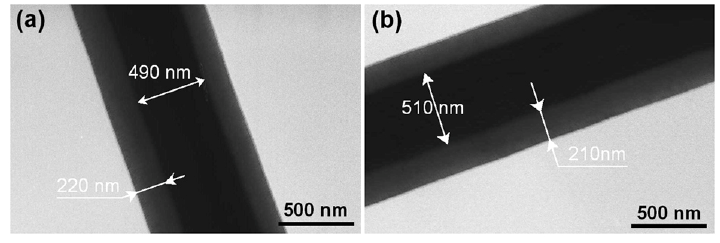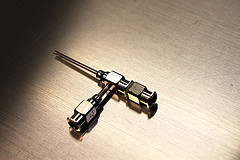Electrospun fibers offer several advantages in the introduction of self-healing property. Self-healing material generally derived this property through encapsulation of curable components within its structure. Damaged to the material will release the repair agents and initiate the self-healing process. Small diameter of electrospun fibers allow uniform coverage over the material to be protected with minimal influence on the bulk material properties. Any release of the repair agent will also be localized and with greater precision on the dosage as the agents come in small packages. Self-healing functionality through different approaches using electrospun fibers have been proposed although they are mostly based on core-shell fibers. In general, two parts need to be present for the healing process, the monomer and the curing agent. The separation and distribution of the two parts need to be considered when designing the self-healing material.
A common method of separating the two parts is to have the curing agent in the core of the core-shell fibers and the monomers distributed within the bulk matrix material to be protected. Lee et al (2014) electrospun a core-shell fiber comprising of poly(acrylonitrile) (PAN) as the shell and curing agent, dimethyl methylhydrogen siloxane as the core. Fabrication of this core-shell fiber was through emulsion electrospinning which negates the need for a co-axial nozzle. The resin monomer was distributed within the epoxy matrix as emulsified liquid droplets of dimethylvinyl-terminated dimethylsiloxane resin monomer. The electrospun fibers were coated on the surface of the epoxy matrix so that any surface damage will release the curing agent and heal the compromised matrix. A limitation of this technique is that the resin monomer droplets that were encapsulated deeper in the matrix would probably not have any chance to participate in the healing process. A better method may be to have both the curing agent and the resin monomer close or at the surface of the matrix such that the mechanical strength of the matrix need not be unnecessarily compromised by the presence of uncured monomers.
In a more elaborate setup, the reacting components may be individually encapsulated within separate core-shell fibers and electrospun on the surface of the material to be protected. Park et al (2010) created a self-healing coating using core-shell electrospinning where the two parts siloxanes were separately encapsulated within poly(vinylpyrrolidone) (PVP) shell for deposition on the substrate. The electrospun core-shell fiber mixtures were then embedded within a polyurethane coating. Successful passivation of the substrate from the environment was demonstrated when the polyurethane surface was scratched.
Electrospun nanofibers have been demonstrated to improve fracture toughness in laminated composites. To introduce an additional mode of protection, the electrospun nanofibers have been used to incorporate self-healing functionality at the interface. Wu et al (2013) used co-axial electrospinning to seal liquid dicyclopentadiene (DCPD) monomer, which is the healing agent, within polyacrylonitrile (PAN) to form core-shell DCPD/PAN nanofibers. The epoxy matrix contains a tiny quantity of Grubbs' catalyst which would initiate polymerization of DCPD upon contact. Once there is interfacial delamination and the core-shell fiber is broken, the released DCPD monomers will undergo polymerization in the presence of the Grubbs' catalyst and heal the delaminated site. The self-healing composite was able to demonstrate good stiffness recovery of 70% to 100%.
Epoxy is commonly used in the construction of composite but it has a relative higher viscosity compared to other solution monomers which makes encapsulation within electrospun fibers more challenging. Mitchell and Keller (2012) were able to encapsulate low viscosity epoxy in electrospun fibers using core-shell electrospinning with the epoxy in the core and poly(vinyl alcohol) (PVA) as the shell material. However, the challenge in epoxy encapsulation was also shown by the presence of beads on the fibers with the epoxy concentrating in the beads instead of along the length of the fibers. Since electrospun nanofibers have been shown to improve the fracture toughness of carbon-fiber-epoxy composites, the ability to encapsulate epoxy in nanofibers may enable repair of the composite with the same matrix material.
Published date: 26 March 2015
Last updated: 13 October 2015
▼ Reference
-
Lee M W, An S, Lee C, Liou M, Yarin A L, Yoon S S. Hybrid Self-Healing Matrix Using Core-Shell Nanofibers and Capsuleless Microdroplets. ACS Appl. Mater. Interfaces 2014; 6: 10461.
-
Mitchell T J, Keller M W. Coaxial electrospun encapsulation of epoxy for use in self-healing materials. Polym Int 2013; 62: 860.
-
Park J H, Braun P V. Coaxial Electrospinning of Self-Healing Coatings. Adv. Mater. 2010; 22: 496
-
Wu X F, Rahman A, Zhou Z, Pelot D D, Shinha-Ray S, Chen B, Payne S, Yarin A L. Electrospinning Core-Shell Nanofibers for Interfacial Toughening and Self-Healing of Carbon-Fiber/Epoxy Composites. J. Appl. Polym. Sci. 2013; 129: 1383.
▲ Close list
 ElectrospinTech
ElectrospinTech

